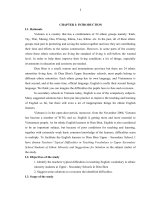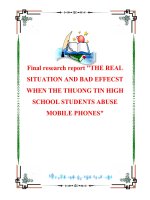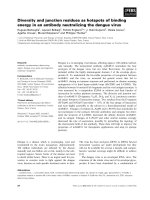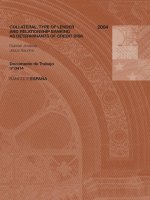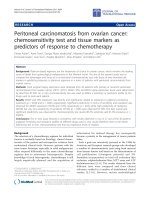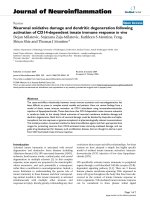Language exposure and subject familiarity as correlates of senior secondary school students’ achievement in narrative writing
Bạn đang xem bản rút gọn của tài liệu. Xem và tải ngay bản đầy đủ của tài liệu tại đây (2.07 MB, 10 trang )
Vol. 7, 2020
A new decade
for social changes
ISSN 2668-7798
www.techniumscience.com
9
772668
779000
Technium Social Sciences Journal
Vol. 7, 98-106, May 2020
ISSN: 2668-7798
www.techniumscience.com
Language exposure and subject familiarity as correlates of
senior secondary school students’ achievement in narrative
writing
Oladotun Opeoluwa Olagbaju1, Nurudeen Oluwaseun Jimoh2
Department of Linguistic Education, College of Education and Social Sciences,
Legacy University of Gambia1, Department of English and Language Arts - American
International Academy, Burundi2
,
Abstract. Narrative writing is often an option in English composition examination, especially in
WAEC/NECO conducted English language Paper 1. Performance in essay writing has been
found to determine the overall success in English language. Efforts to improve students’
performance in the subject have largely focused on instructional strategies without much
attention to process-based variables such as language exposure and subject familiarity that can
influence learning outcomes in ESL classrooms. Despite the contributions of these studies to
pedagogical practices in ESL classroom, students’ achievement in English composition has not
improved significantly. However, process-related variables such as quality and volume of
exposure to the target language and subject familiarity have been found to predict learning
outcomes in a second/foreign language classroom. Therefore, this study examined the
relationship between language exposure and subject familiarity on achievement in narrative
essay. The study tested three null hypotheses and a total of 350 participants were randomly
selected from four senior secondary schools in Ibadan North Local Government Area, Nigeria.
Data was collected using two research instruments and the results showed a positive nonsignificant relationship between the independent variables and students’ achievement in
narrative essay. Also, there were no composite and relative contributions of language exposure
and subject familiarity to students’ achievement in expository essay.
Keywords. Achievement, Language Exposure, Subject Familiarity, Narrative Essay, ESL
Instruction
Introduction
Proficiency in the four language skills of the English language continues to accrue social
prestige both in formal and informal settings in Nigeria. Literacy in English language has
remained one of the hallmarks of an ‘educated’ Nigerian because the ability to speak, read,
write and communicate fluently in English remains a significant factor when parents want to
determine or assess the quality of education in schools. This is because English plays a
significant roles in education, administration, legislation, business transaction, entertainment,
and inter-ethnic relations as the official language and lingua franca in Nigeria.in education, for
example, English plays a dual role of being the language of instruction progressively from the
fourth year of basic/primary education to the higher institutions of learning (FGN, National
98
Technium Social Sciences Journal
Vol. 7, 98-106, May 2020
ISSN: 2668-7798
www.techniumscience.com
Policy on Education, 2004). English is also one of the core subjects in the Nigerian educational
system and a minimum of a credit pass in the subject is a strong requirement for admissions
into any of the higher institutions of learning in Nigeria.
English language remains indispensable vehicle of communication in the Nigerian educational
and social systems. High premium is placed on proficiency in reading, speaking and the quality
of students’ wiring in most schools. Therefore, there has been several research efforts aimed at
improving the quality of instructions in schools through learner-centred strategies (Atanda &
Jaiyeoba, 2011), social media-supported instruction (Olagbaju & Popoola, 2020),
communicative styles (Ogunyemi & Olagbaju, 2020) and so on. In spite of these interventions
in second language instruction in Nigeria, many students still find English language difficult as
attested to by the perennial mass failure usually recorded in the subject especially in public
examinations. Essay writing is allotted the highest mark in English Language Paper 1 and
success in composition writing has been found to guarantee overall success in the subject.
Considering the importance of essay writing to students’ achievement in English language,
efforts at improving performance in English language have largely focused on improving
instructional procedures in composition writing. However, performance in essay writing has
been very poor. For example, WAEC Chief Examiners’ Report (2019) states that although the
essay questions were clear, candidates failed to show understanding of the questions they
attempted. Also, errors in grammar, spelling and punctuation also dominated candidates’
essays. The report concluded that teachers need to help candidates by teaching them how to
read, understand and interpret the requirements of the different aspects of the examination,
especially essay writing.
The choice of narrative essay type in this study was informed by the fact it is one of the options
mostly attempted by students in WAEC/NECO conducted examinations; it is only next to letter
writing. The narrative essay requires the writer to retell or recount a past experience or event
that they have witnessed, heard or imagined (Akinborewa & Olagbaju, 2010). It is an essay
type preferred by most learners because it is more or less like a narration of a story or past event.
The process of instruction and students’ achievement in English composition has been
bedeviled by several learner and classroom-related factors within and outside the ESL
classroom in Nigeria. Therefore, it is important to examine other factors within the classroom
that can contribute to students’ achievement in essay writing. Some of these factors include
subject familiarity, language exposure, teaching style, students’ prior knowledge, phonological
variations, verbal ability, language anxiety and so on.
Language exposure and subject familiarity are capable of influencing ESL students’
achievement in essay writing irrespective of the quality of instruction delivered by the teacher.
Language exposure deals with the number of contact hours in form of instruction and classroom
interaction that students are able to access in a particular subject. In the context of this study,
language exposure refers to the contact that the students have with the target language in and
out of the classroom. The processes involved in the teaching and learning of a second language
in a multilingual environment can be frustrating for both the teacher and learner. However, the
ESL learning activities can be planned and enriched through quality and adequate exposure to
the target language. Exposure allows ESL learners to progressively amass the knowledge and
rules of the target language until they attain a high level of proficiency. Obanya (2002) avers
that instruction in a second language classroom should be multidimensional in approach. In the
process of instruction in ESL classroom, learners should have adequate exposure in terms of
depth in quality and quantity of the target language that they come in contact with.
Exposure in second language learning refers to the contact that the learners have with the
language that they are trying to learn within and outside the classroom. Language exposure
99
Technium Social Sciences Journal
Vol. 7, 98-106, May 2020
ISSN: 2668-7798
www.techniumscience.com
could be in the form of access to the target language in daily communication or the volume of
the contact situations that the ESL learner has acquired through instruction in the target
language over a period of time. Stressing the importance of language exposure in ESL
classroom, Gilakjani and Ahmadi (2011) posits that activities in second language instruction
are basically done through communicative inputs that are comprehensible to develop the skills
and knowledge of the culture of the target language. Adequate and quality exposure to the target
language can improve ESL students’ mastery of the writing. However, when ESL learners are
not adequately exposed to the target language through contact situations, Shumin (1997) posits
that they cannot effectively master the skills of the target language.
Similarly, subject familiarity deals with the level of acquittance with a topic, process or task
that learners have master. Norman (2015) considers reading as the key to unlocking subject
familiarity because the more readers read, the more they encounter general and specific words
related to the topics. Learners with knowledge of the topic or essay type are likely to write better
than those that are not familiar with what is required. This implies that subject familiarity gives
an advantage to learners in language learning situation. Subject familiarity provides a platform
for students to recall or transfer previous learning or experiences in actual classroom situations.
Horiba and Fukaya (2015) reported that topic familiarity affected the processing and
representing detailed information that is relevant to the topic of interest.
Also, Al-Shumaimeri (2006) investigated the effects of language ability and content familiarity
on foreign language learning and found that subject familiarity had a significant effect on
learnings in reading. However, studies on subject familiarity on ESL/EFL instruction have
largely focused on the reading skill with little or no literature on the relationship between
subject familiarity and language exposure on students’ achievement in composition writing.
Therefore, this determined the relationship between language exposure and subject familiarity
and students’ achievement in narrative essay.
Statement of the Problem
Learning to write in a second language can be a difficult experience because learners need to
acquire knowledge of the rules and aspects of the target to be able to write effectively. Writing
is a skill that is critical to success in formal education and preservation of information. In spite
of the importance of this language skill to mankind, achievement in writing has been very poor
largely because instruction procedures in writing are too structured and the role of factors such
as language exposure and subject familiarity among others, are not being considered. Several
efforts to address these problems have been made by researchers but the problem of mass failure
and poor quality of essays still persist. To ameliorate these problems, it is important to examine
other factors that can contribute to success in essay writing within and outside the ESL such as
language exposure and subject familiarity. Past studies on the relationship between these two
factors and students’ learning outcomes in English language largely focused on reading.
Therefore, this study determined the language exposure and subject familiarity as correlates of
students’ achievement in narrative essay.
Hypotheses
Based on the stated problems, the following null hypotheses were tested at 0.05 level of
significance.
Ho1: There is no significant relative relationship between the independent variables (Language
Exposure and Subject Familiarity) and students’ achievement in narrative essay.
Ho2: There is no significant composite contribution of independent variables (Language
Exposure and Subject Familiarity) and students’ achievement in narrative essay
100
Technium Social Sciences Journal
Vol. 7, 98-106, May 2020
ISSN: 2668-7798
www.techniumscience.com
Ho3: There is no significant relative contribution of independent variables (Language Exposure
and Subject Familiarity) and students’ achievement in narrative essay
Anderson’s Schema Theory
Richard Anderson (1978) contributed to the development of the schema theory. The theory
describes the processes involved in knowledge acquisition and organisation. Schema or
schemata refers to a mental framework used by humans to represent and organise information
which aids easy recall. Schemata are derived from learners’ prior knowledge and used to modify
behaviour, or predict likely outcomes of events. People use schemata to organise knowledge
through a complex mental activity which also provides framework for future understanding.
Language exposure and subject familiarity as considered in this study are capable of impeding
or facilitating learning during the process of classroom instruction. Learning is constructed by
students’ schema (language exposure and subject familiarity) to create a connection between
learners’ schema and language instruction to facilitate self-regulated learning.
Classroom-Related Factors in Narrative Writing Pedagogy
The teaching of writing in ESL classrooms in Nigeria covers different essay types which include
letter, article and speech writing, descriptive, expository, argumentative and narrative essays.
Narrative essay requires the writer to tell story or retell a real or fictional event that he or she
has witnessed, experienced or imagined. Current trends in pedagogy have shown that the
teaching of narrative essay in schools has become more learner-centric but even at that,
performance in essay writing has not improved significantly. This is because there are certain
factors that exist in the classroom in terms of the learners’ characteristics, classroom
atmosphere, frequency of teacher-learner contact and so on, which can influence students’
learning outcomes. Some of such factors are language exposure and subject familiarity in the
teaching and learning process. Research (Ogunyemi & Olagbaju, 2020) lends support to the
idea that the style of communication in teacher-students or student-context/text contact has a
significant impact on students’ learning outcomes in English language classroom.
Language exposure in classroom instruction goes beyond the amount of time the teacher spends
in class. It also covers the quality of instruction that the ESL students are exposed to during
those contact hours or periods on the timetable. Exposure in language learning situations
comprises opportunities to make use of the target language within and outside the classroom,
contact with teacher, interaction with texts and other learning materials. It is also logical to
argue that high volume of teacher-student contact or student-content interaction and other forms
of exposure to the target language will facilitate an improved students’ achievement in the
subject.
Subject familiarity on the hand deals with students’ prior knowledge accounted for primarily
by schema-based models of comprehension which propose that pre-stored schemata that
enhances learning and reception of new ideas. Familiarity with the vocabularies and rules of
the target language is an important aspect of second language learning. Second language
learners with greater knowledge of a particular topic, skill or expertise in an essay type will
obviously perform better than classmates that are novice with regards to the topic or task
required. Martínez (2014) posits that the teaching of a foreign language classroom is affected
by familiarity of content or readers’ prior knowledge of the content of the text, and gender.
McCrudden, Stenseth, Bråten, and Strømsø (2015) describe topic familiarity as a form of prior
knowledge which is an important factor in the acquisition of new knowledge. Horiba and
Fukaya (2015) posit that topic familiarity has a profound effect on both learning of the content
of a text and incidentally vocabulary learning from the context; and it may influence content
101
Technium Social Sciences Journal
Vol. 7, 98-106, May 2020
ISSN: 2668-7798
www.techniumscience.com
recall. Thus, the level of subject familiarity is directly proportional to the comprehension of the
processes involved in the task or knowledge to be accomplished or learned.
Language exposure and subject familiarity are two different factors in second language
instruction that are interrelated because the former can determine the latter. When learners have
unlimited access to a resource person or learning materials in the course of second language
learning, the level of subject or topic familiarity will significantly improve. Exposure to the
skills of the target language in and outside the classroom can improve the level of familiarity
with the subject (language) and reduce language anxiety. When ESL learners are adequately
exposed to rudiments of writing a narrative composition, they will become familiar with the
requirements of writing a narrative essay in a public examination such as the length (L), content
(C), organization (O), expression (E) and mechanical accuracy (MA). Other requirements
include the essay format/outline, paragraphing, punctuations, consistency in spellings and so
on. Therefore, this study determines the relationship between language exposure and subject
familiarity and students’ achievement in narrative writing.
Research Methodology
Research Design and Population
The study adopted a descriptive research design of survey type using qualitative and
quantitative methods of data analysis. The study population consists of all the senior secondary
school students in Ibadan North Local Government Area of Oyo State, Nigeria. A simple
random sampling was used to select three schools from the public schools in the LGA and a
total of 280 SS2 students were randomly selected for the purpose of this study.
Variables
The independent variables are Language Exposure and Subject Familiarity while the dependent
variable is ESL students’ achievement in narrative composition.
Instruments and Validation Process
Two research instruments were used for the purpose of data collection and these are Language
Exposure and Subject Familiarity Questionnaire (LESFQ) and Students’ Achievement Test in
Narrative Writing (SATNW). The instruments were designed by the researcher to elicit
responses from participants. LESFQ has two parts, the aspect on language exposure is a 10item instrument with two-point scoring scale. The aspect on subject familiarity equally has 10
items with a four-point likert scale of High (4), Average (3) Low (2) and Novice (1). The second
instrument, SATNW was a past WAEC question on narrative essay. As a standardised test, it
was written under similar examination conditions and was marked using the same procedures
by WAEC examiners using WAEC-recommended raters’ guide. LESFQ was trial-tested on a
sample of 40 students which were not be part of the study sample. Their responses were
analyzed using Cronbach alpha statistics and a coefficient of 0.64 was recorded.
Data Analysis
The data was analyzed using inferential statistics such as Pearson Product Moment Correlation
(PPMC), Multiple Regression Analysis (MRA), mean and standard deviation.
Results and Discussions
Ho1: There is no significant relative relationship between the independent variables (Language
Exposure and Subject Familiarity) and students’ achievement in narrative essay.
102
Technium Social Sciences Journal
Vol. 7, 98-106, May 2020
ISSN: 2668-7798
www.techniumscience.com
Table 1: Relative Relationship of Each of the Independent Variables with Students’
Achievement in Narrative Essay
Variables
Students’
Language
Subject
Achievement Exposure
Familiarity
in Narrative
Essay
Students’
1
Achievement in
Narrative Essay
Language
.039 (.466)
1
Exposure
Subject
.078 (.146)
.076 (.157)
1
Familiarity
N
350
350
350
Mean
19.84
17.04
31.70
Standard
5.18
1.81
5.34
Deviation
Table 1 shows the relationship each of the independent variables (Language Exposure and
Subject Familiarity) and students’ achievement in narrative essay. The result indicates that
language exposure had a positive non-significant relationship with students’ achievement in
narrative essay (r = .039; p>.05). This implies that the more students were exposed to language,
the more their achievement in narrative essay, hence, language exposure could have a positive
influence on students’ achievement in narrative essay. The table also indicates that subject
familiarity had a positive non-significant relationship with students’ achievement in narrative
essay (r = .078; p>.05). This also implies that the more students were familiar with the subject
of discourse, the more their achievement in narrative essay. Based on these result, the null
hypothesis one is hereby accepted that there is no significant relative relationship between the
independent variables (Language Exposure and Subject Familiarity) and students’ achievement
in narrative essay.
Ho2: There is no significant composite contribution of independent variables (Language
Exposure and Subject Familiarity) and students’ achievement in narrative essay
Table 2: Regression Analysis of the Composite Contribution of the Independent
Variables with Students’ Achievement in Narrative Essay
R = .085a; R Square = .007; Adjusted R Square = .001; Std.
Error of the Estimate = 5.18579
Sum of
Mean
Model
Squares
Df Square
F
Sig.
1 Regression
67.361
2 33.680 1.252 .287b
Residual
9331.679 347 26.892
Total
9399.040 349
Table 2 shows that there was no significant composite contribution of Language Exposure and
Subject Familiarity to students’ achievement in narrative essay (F (2; 347) = 1.252; Adj. R2 = .001;
p=.287>.05). This implies that the two independent variables when pulled together did not
significantly contribute to students’ achievement in narrative essay. Therefore, the null
hypothesis 2 is hereby accepted.
103
Technium Social Sciences Journal
Vol. 7, 98-106, May 2020
ISSN: 2668-7798
www.techniumscience.com
Ho3: There is no significant relative contribution of independent variables (Language Exposure
and Subject Familiarity) and students’ achievement in narrative essay
Table 3: Regression Analysis of the Relative Contribution of the Independent Variables
with Students’ Achievement in Narrative Essay
Unstandardized Standardized
Coefficients
Coefficients
Std.
Model
B
Error
Beta
t
Sig.
1
(Constant) 15.894
2.999
5.299 .000
Subject
.073
.052
.075 1.404 .161
Familiarity
Language
.095
.154
.033 .622 .535
Exposure
Table 3 shows that the relative contribution of each of the independent variables (Language
Exposure and Subject Familiarity) and students’ achievement in narrative essay. The result
indicates that there is no significant relative contribution of language exposure (β = .033;
p=.535>0.05) and subject familiarity (β = .075; p=.161>0.05) to students’ achievement in
narrative essay. This implies that the Language exposure and subject familiarity did not
individually have significant contribution to students’ achievement in narrative essay.
Therefore, the null hypothesis 3 is hereby accepted. However, subject familiarity (β = .075) had
higher beta weight and more contribution to students’ achievement in narrative essay than
language exposure, though this contribution was not statistically significant.
The findings of this study showed that language exposure and subject familiarity had positive
non-significant relationship with students’ achievement in narrative essay. This result implies
that higher level of language exposure and subject familiarity in the ESL classroom can predict
improved achievement in narrative essay. The findings of this study is in support Bhelda (1999)
and Gilakjani and Ahmadi (2011) that quality exposure to the target language correlates with
ESL/EFL students’ achievement. Obayan (2002) also stressed the importance of quality
linguistic inputs through exposure to the target language in ESL classroom. When learners are
exposed to the target language through quality instruction that encourages communicative
inputs and interactions, they become more familiar with the topic and this improves their
achievement in the subject. The result also supports the findings of Chan (2013) that modelling
and exposure to the target language contributes positively to students’ achievement in ESL
learning classrooms. Similarly, subject familiarity had no significant relationship with students’
achievement in narrative essay. The findings of this study support Horiba and Fukaya (2015)
that topic familiarity has a profound effect on students’ achievement, recall and learning of text
content and vocabulary from the context. Martínez (2014) also found the relationship between
subject familiarity and students’ achievement to be positively significant.
In addition, the findings of this study showed that there is no significant composite contribution
of language exposure and subject familiarity to students’ achievement in narrative writing. It is
logic al that the composite contribution of language exposure and subject familiarity to
students’ achievement in English language because if learners have adequate access to resource
persons and learning resources or materials in the course of second language learning, the level
of subject or topic familiarity will significantly improve. Exposure to the target language skills
within and outside the ESL classroom can improve subject familiarity and students’
104
Technium Social Sciences Journal
Vol. 7, 98-106, May 2020
ISSN: 2668-7798
www.techniumscience.com
achievement. When ESL learners have adequate exposure to the rudiments of narrative
composition, there is likely to be an improvement in their performance.
Similarly, the findings of this study showed that there is no significant relative contribution of
learning exposure and subject familiarity to students’ achievement in narrative essay. By
implication, the findings of this study showed that when the contributory effect of language
exposure and subject familiarity were examined separately, they do not contribute to students’
achievement in narrative essay.This result is at variance with the findings of Chan (2013) and
McCrudden, Stenseth, Bråten, and Strømsø (2015) that each of language exposure and subject
familiarity have significant relative contributions to students’ achievement in English language
and English vocabulary respectively. However, the result supports Nelson-Sathi (2013) that
factors like phonological variations and exposure are capable of hindering students’ learning
outcomes in ESL classrooms.
Conclusion and Recommendations
Narratives are taught in both reading and writing skills as part of instruction n in English studies
in ESL classrooms in Ibadan North LGA. Almost all the public examination bodies in Nigeria
set question on narrative essay annually because such a composition requires learners to retell
or recreate an encounter that they once read, heard, witness or experienced. Therefore, the
students are expected to be familiar with the right choice of tenses, and the rudiments of writing
a story. This study examined the relationship between language exposure and subject familiarity
and ESL students’ achievement in narrative essay. Results showed that there are no significant
relationships between language exposure and subject familiarity and achievement in narrative
essay. Also, there are no composite and relative contributions of the independent variables to
students’ achievement in narrative essay in Ibadan North local government Area of Oyo State,
Nigeria. Based on this result, the following recommendations are made:
1. ESL teachers should pay close attention to language exposure and subject familiarity as
processes within instructional delivery in ESL classroom and ameliorate the effect of
such factors through adequate exposure and students’ involvement during instructional
delivery.
2. Teachers should ensure that students are adequately exposed to human and material
resources in terms of volume and quality during instructional delivery till they are able
to ‘own the new knowledge’.
3. Students should be encouraged to interact with instructional resources within and
outside the classroom to familiarize themselves with the topic or process.
4. Learning should be engaging and student-material focused in ESL classroom.
[1] References
[2] Akinborewa, T. and Olagbaju, O.O. (2010). Simplified Composition Workbook. Ibadan:
Joytal Printing Press.
[3] Al-Shumaimeri, Y.A.N. (2006). The effects of content familiarity and language ability
on reading comprehension performance of low and high-ability Saudi Tertiary students
studying English as a Foreign Language. Journal of Educational Sciences & Islamic
Studies, 18(2): 1-19.
[4] Anderson, R.C. (1978). Schema-directed processes in language comprehension.
Cognitive psychology and instruction, 67-82.
[5] Atanda, A.I & Jaiyeoba, A.O. 2011.Effects of school-based quality factors on
Secondary School Students’ Achievement in English Language in South-Western and
North-Central Nigeria. Journal of Emerging Trends in educational Research and Policy
JETEKAPS) 2(2), 93-99.
105
Technium Social Sciences Journal
Vol. 7, 98-106, May 2020
ISSN: 2668-7798
www.techniumscience.com
[6] Bhela, B. (1999). Native language interference in learning a second language.
International Education of Journal Vol. 1(1): 27-35. Retrieved 17 February, 2020
from iej.cjb.net.22
[7] Chan, J.Y.H. (2013). Exposure to accents and pronunciation modelling: A case study of
a secondary school in Hong Kong. International Journal of Applied Linguistics, 24(3):
84-93
[8] Federal Republic of Nigeria (2004). National Policy on Education (Revised). Abuja:
NERDC Press.
[9] Gilakjani, A.P. and Ahmadi, M.R. (2011). Why is pronunciation so difficult to learn?
English Language Teaching Vol. 4 (3):74-83. Retrieved online 10th January, 2020 from
www.ccsenet.org/elt
[10]
Horiba, Y. and Fukaya, K. (2015). Reading and learning from L2 text:
Effects of reading goal, topic familiarity and language proficiency. Reading in a Foreign
Language, 27 :22-46
[11] Martinez, A.C.L. (2014). Analysis of the effect of content familiarity and gender on
English as a foreign language reading comprehension by Spanish University students.
Porta Linguarum
[12] McCrudden, M. T., Stenseth, T., Bråten, I., & Strømsø, H. I. (2015). The Effects of
Topic Familiarity, Author Expertise, and Content Relevance on Norwegian Students’
Document Selection: A Mixed Methods Study. Journal of Educational Psychology.
Advance online publication. />[13] Nelson-Sathi, S. (2013). Reconstructing the lateral component of language history and
genome using network approaches. Chapter in book: Reconstructing the lateral
component of language history and genome evolution in biology. Fangerau, H., Geisler,
H., Halling, T. and Martin, W. (Eds). Publisher: Franz Steiner Verlag.
[14] Norman, A. H. (2015). Topic familiarity and vocabulary knowledge: Implications For
instructions. National Seminar Proceeding. Universitas Negeri Malang.
[15]
Obanya, P.A.I. (2002). Curriculum Overload in the Language Education
Programme for Basic Education in Adebayo, L., Isiugo–Abanihe, I., and Ohi, I.N. (Eds)
Perspectives on Applied Linguistics in Language and Literature. Ibadan: StirlingHorden Publishers (Nig) Ltd.
[16] Ogunyemi, K. O., & Olagbaju, O. O. (2020). Effects of Assertive and Aggressive
Communication Styles on Students’ Self-Esteem and Achievement in English
Language. Cross-Cultural Communication, 16(1): 96-101.
[17] Olagbaju, O.O. & Ogunyemi, K.O. (2020). Phonological Variations and Language
Exposure as Correlates of Achievement in Silent Sounds in ESL Classrooms in Ibadan
South-East LGA, Nigeria. International Journal of Literature, Language and
Linguistics, 6(1): 255-262.
[18] Olagbaju, O.O. & Popoola, A.G. (2020). Effects of Audio-Visual Social Media
Resources-Supported Instruction on Senior Secondary Schools Students’ Learning
Outcomes in Reading. International Journal of Technology in Education 3 (2): 92-104.
[19]
Shumin, K. (1997). Factors to consider: developing adult EFL students’
speaking abilities. Forum 25 (3), 8. Somali: A language of Somalia. (n.d.) Ethnologue
report for language code; SOM.
[20] West African Examinations Council (2019). Chief Examiners’ Report for the West
African Senior School Certificate Examination (WASSCE). Lagos: WAEC Press.
106

